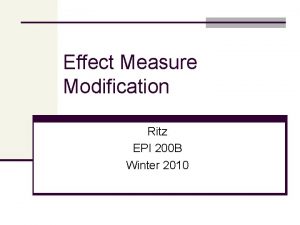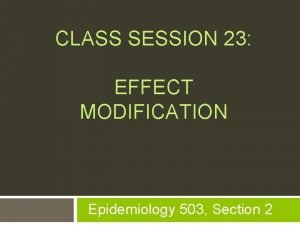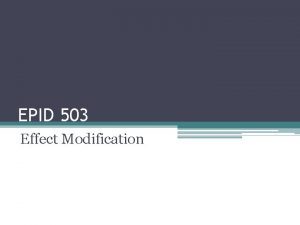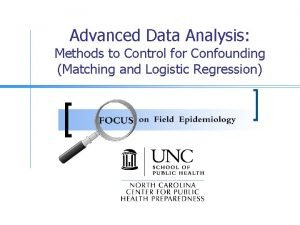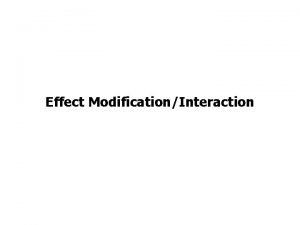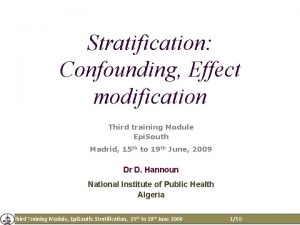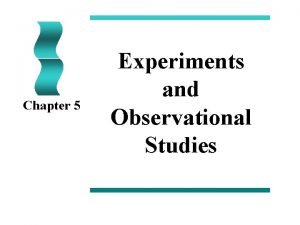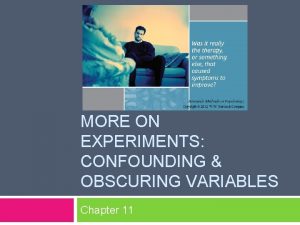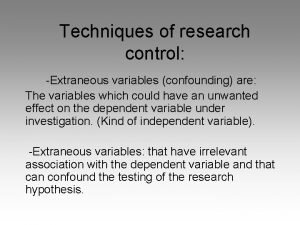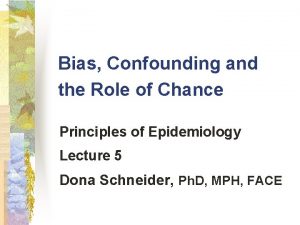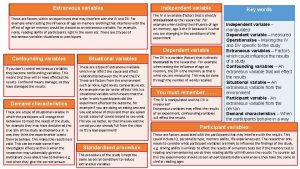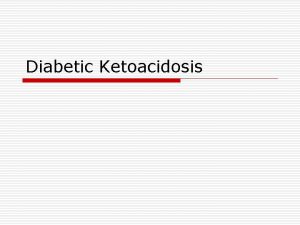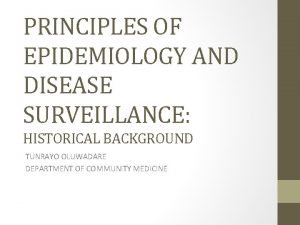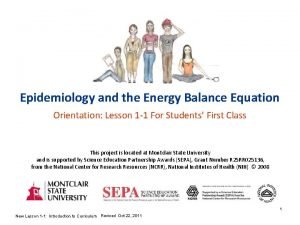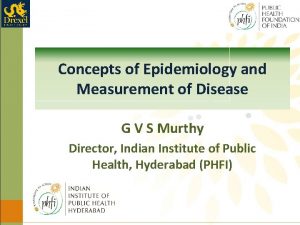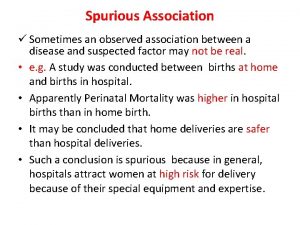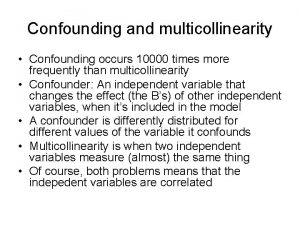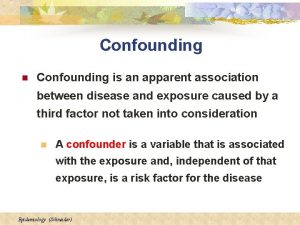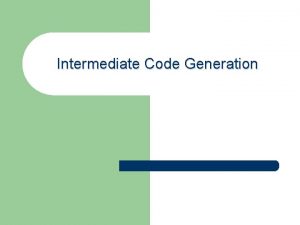COMH 7202 EPIDEMIOLOGY III INTERMEDIATE CONCEPTS Confounding Effect





































- Slides: 37

COMH 7202: EPIDEMIOLOGY III – INTERMEDIATE CONCEPTS Confounding & Effect Modification Peter. Nyasulu@wits. ac. za

Confounding • If you don't know whether an effect is caused by the variable you are interested in (e. g. a drug or smoking) or by another variable (e. g. age or sex) then the other variable is called a confounder and it is said to cause confounding. • To be a confounder a variable must be associated both with the exposure you are interested in and the outcome you are analysing.


Cases of Down Syndrome by Birth Order

Cases of Down Syndrome by Age Groups

Cases of Down Syndrome by Birth Order and Maternal Age

Confounding • A third factor which is related to both exposure and outcome, and which accounts for some/all of the observed relationship between the two factors • Confounder not a result of the exposure – e. g. , association between child’s birth rank (exposure) and Down syndrome (outcome); mother’s age a confounder? – e. g. , association between mother’s age (exposure) and Down syndrome (outcome); birth rank a confounder?

Confounding To be a confounding factor, two conditions must be met: Exposure Outcome Third variable Be associated with exposure - without being the consequence of exposure Be associated with outcome - independently of exposure (not an intermediary)

Confounding Birth Order Down Syndrome Maternal Age Maternal age is correlated with birth order and a risk factor even if birth order is low

Confounding ? Maternal Age Down Syndrome Birth Order Birth order is correlated with maternal age but not a risk factor in younger mothers

Confounding Coffee CHD Smoking is correlated with coffee drinking and a risk factor even for those who do not drink coffee

Confounding ? Smoking CHD Coffee drinking may be correlated with smoking but is not a risk factor in nonsmokers

Confounding Alcohol Lung Cancer Smoking is correlated with alcohol consumption and a risk factor even for those who do not drink alcohol

Confounding ? Smoking CHD Yellow fingers Not related to the outcome Not an independent risk factor

Confounding ? Diet CHD Cholesterol On the causal pathway

Confounding Imagine you have repeated a positive finding of birth order association in Down syndrome or association of coffee drinking with CHD in another sample. Would you be able to replicate it? If not why? Imagine you have included only non-smokers in a study and examined association of alcohol with lung cancer. Would you find an association? Imagine you have stratified your dataset for smoking status in the alcohol - lung cancer association study. Would the odds ratios differ in the two strata? Imagine you have tried to adjust your alcohol association for smoking status (in a statistical model). Would you see an association?

Confounding Imagine you have repeated a positive finding of birth order association in Down syndrome or association of coffee drinking with CHD in another sample. Would you be able to replicate it? If not why? You would not necessarily be able to replicate the original finding because it was a spurious association due to confounding. In another sample where all mothers are below 30 yr, there would be no association with birth order. In another sample in which there are few smokers, the coffee association with CHD would not be replicated.

Confounding Imagine you have included only non-smokers in a study and examined association of alcohol with lung cancer. Would you find an association? No because the first study was confounded. The association with alcohol was actually due to smoking. By restricting the study to non-smokers, we have found the truth. Restriction is one way of preventing confounding at the time of study design.

Confounding Imagine you have stratified your dataset for smoking status in the alcohol - lung cancer association study. Would the odds ratios differ in the two strata? The alcohol association would yield the similar odds ratio in both strata and would be close to unity. In confounding, the stratum-specific odds ratios should be similar and different from the crude odds ratio by at least 15%. Stratification is one way of identifying confounding at the time of analysis. If the stratum-specific odds ratios are different, then this is not confounding but effect modification.

Confounding Imagine you have tried to adjust your alcohol association for smoking status (in a statistical model). Would you see an association? If the smoking is included in the statistical model, the alcohol association would lose its statistical significance. Adjustment by multivariable modelling is another method to identify confounders at the time of data analysis.

Confounding For confounding to occur, the confounders should be differentially represented in the comparison groups. Randomisation is an attempt to evenly distribute potential (unknown) confounders in study groups. It does not guarantee control of confounding. Matching is another way of achieving the same. It ensures equal representation of subjects with known confounders in study groups. It has to be coupled with matched analysis. Restriction for potential confounders in design also prevents confounding but causes loss of statistical power (instead stratified analysis may be tried).

Confounding Randomisation, matching and restriction can be tried at the time of designing a study to reduce the risk of confounding. At the time of analysis: Stratification and multivariable (adjusted) analysis can achieve the same. It is preferable to try something at the time of designing the study.

Effect of randomisation on outcome of trials in acute pain Bandolier Bias Guide

Confounding Obesity Mastitis Age In cows, older ones are heavier and older age increases the risk for mastitis. This association may appear as an obesity association

Confounding If each case is matched with a same-age control, there will be no association (OR for old age = 2. 6, P = 0. 0001)

No Confounding

Cases of Down Syndrome by Birth Order and Maternal Age If each case is matched with a same-age control, there will be no association. If analysis is repeated after stratification by age, there will be no association with birth order.

Confounding or Effect Modification Birth Weight Leukaemia Sex Can sex be responsible for the birth weight association in leukaemia? - Is it correlated with birth weight? - Is it correlated with leukaemia independently of birth weight? - Is it on the causal pathway? - Can it be associated with leukaemia even if birth weight is low? - Is sex distribution uneven in comparison groups?

Confounding or Effect Modification Birth Weight Leukaemia OR = 1. 5 Sex Does birth weight association differ in strength according to sex? BOYS Birth Weight GIRLS Birth Weight // Leukaemia OR = 1. 8 Leukaemia OR = 0. 9

Effect Modification In an association study, if the strength of the association varies over different categories of a third variable, this is called effect modification. The third variable is changing the effect of the exposure. The effect modifier may be sex, age, an environmental exposure or a genetic effect. Effect modification is similar to interaction in statistics. There is no adjustment for effect modification. Once it is detected, stratified analysis can be used to obtain stratum-specific odds ratios.

Effect modifier Belongs to nature Different effects in different strata Simple Useful Increases knowledge of biological mechanism Allows targeting of public health action Confounding factor Belongs to study Adjusted OR/RR different from crude OR/RR Distortion of effect Creates confusion in data Prevent (design) Control (analysis)

HOW TO CONTROL FOR CONFOUNDERS? • IN STUDY DESIGN… – RESTRICTION of subjects according to potential confounders (i. e. simply don’t include confounder in study) – RANDOM ALLOCATION of subjects to study groups to attempt to even out unknown confounders – MATCHING subjects on potential confounder thus assuring even distribution among study groups

HOW TO CONTROL FOR CONFOUNDERS? • IN DATA ANALYSIS… – STRATIFIED ANALYSIS using the Mantel Haenszel method to adjust for confounders – IMPLEMENT A MATCHED-DESIGN after you have collected data (frequency or group) – RESTRICTION is still possible at the analysis stage but it means throwing away data – MODEL FITTING using regression techniques

Effect of blinding on outcome of trials of acupuncture for chronic back pain Bandolier Bias Guide

Cause-and-Effect Relationship Grimes & Schulz, 2002

WILL ROGERS' PHENOMENON Assume that you are tabulating survival for patients with a certain type of tumour. You separately track survival of patients whose cancer has metastasized and survival of patients whose cancer remains localized. As you would expect, average survival is longer for the patients without metastases. Now a fancier scanner becomes available, making it possible to detect metastases earlier. What happens to the survival of patients in the two groups? The group of patients without metastases is now smaller. The patients who are removed from the group are those with small metastases that could not have been detected without the new technology. These patients tend to die sooner than the patients without detectable metastases. By taking away these patients, the average survival of the patients remaining in the "no metastases" group will improve. What about the other group? The group of patients with metastases is now larger. The additional patients, however, are those with small metastases. These patients tend to live longer than patients with larger metastases. Thus the average survival of all patients in the "with-metastases" group will improve. Changing the diagnostic method paradoxically increased the average survival of both groups! This paradox is called the Will Rogers' phenomenon after a quote from the humorist Will Rogers ("When the Okies left California and went to Oklahoma, they raised the average intelligence in both states"). Festenstein, 1985

References • Gordis: Epidemiology, Saunders, Philadephia • Hennekens CH, Buring JE, Mayrent SL (Eds). Epidemiology in Medicine. Boston: Little, Brown and Company. 1987 • Greenland S & Morgenstern H. Confounding in health research. Annu Rev Public Health 2001; 22: 189 -212 (PDF)
 Ley 7202
Ley 7202 Effect modifier vs confounder
Effect modifier vs confounder Effect modifier
Effect modifier Effect modification epidemiology
Effect modification epidemiology Confounding vs effect modification
Confounding vs effect modification How to control for confounding
How to control for confounding Effect modification vs confounding
Effect modification vs confounding Effect modification vs confounding
Effect modification vs confounding Hamlet act iii scene iii
Hamlet act iii scene iii Cofounding variable
Cofounding variable Strongest research design
Strongest research design How to control for confounding
How to control for confounding Why control for confounding variables
Why control for confounding variables Obscuring variable
Obscuring variable What does extraneous variable mean
What does extraneous variable mean Confounding variable definition psychology
Confounding variable definition psychology Contstrue
Contstrue Extraneous variable
Extraneous variable Example of recall bias
Example of recall bias Wheel of causation vs web of causation
Wheel of causation vs web of causation Cross sectional study advantages and disadvantages
Cross sectional study advantages and disadvantages How dr. wafaa elsadr epidemiology professor
How dr. wafaa elsadr epidemiology professor Diabetic ketoacidosis epidemiology
Diabetic ketoacidosis epidemiology Ramboman analysis
Ramboman analysis What is descriptive study in epidemiology
What is descriptive study in epidemiology Difference between descriptive and analytical epidemiology
Difference between descriptive and analytical epidemiology John snow epidemiology
John snow epidemiology Advantages and disadvantages of nutritional epidemiology
Advantages and disadvantages of nutritional epidemiology Epi
Epi Certification board of infection control and epidemiology
Certification board of infection control and epidemiology Proportion defination
Proportion defination Attack rate epidemiology formula
Attack rate epidemiology formula Epidemiology definition
Epidemiology definition Distribution in epidemiology
Distribution in epidemiology Epidemiology definition
Epidemiology definition Spurious association in epidemiology
Spurious association in epidemiology Descriptive vs analytic epidemiology examples
Descriptive vs analytic epidemiology examples Attack rate calculation
Attack rate calculation

